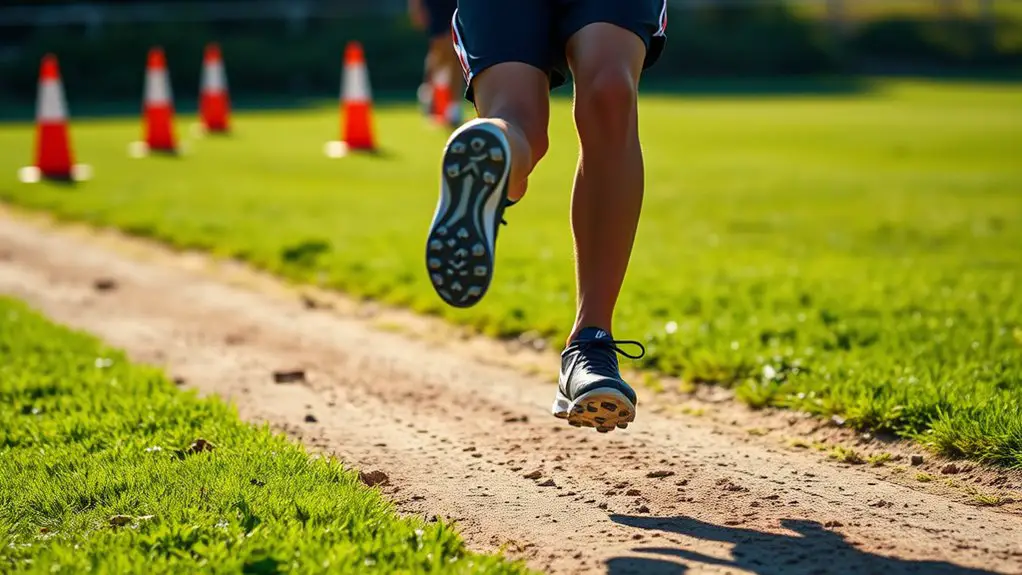To improve your base running agility, focus on ladder drills to develop quick feet, and use cone drills for swift directional changes. Incorporate sprints and acceleration workouts to boost your explosiveness. Don't forget plyometric exercises for enhanced power and base running simulation drills to practice real-game scenarios. Each drill sharpens your skills, preparing you for peak performance. Keep going to uncover additional techniques that can elevate your game even further.
Ladder Drills for Quick Feet
Ladder drills are an excellent way to develop quick feet, which are essential for effective base running. By incorporating various ladder variations into your training routine, you can enhance your agility and footwork techniques. These drills force you to focus on precision and speed, allowing you to break free from sluggish movements on the field.
You can start with basic in-and-out steps and progress to more complex patterns like lateral shuffles or single-leg hops. Each variation challenges your coordination and balance, honing your body's ability to respond swiftly during a game. Agility training techniques like these can significantly improve your overall performance, giving you the freedom to maneuver around the bases with confidence. Consistent practice will not only sharpen your footwork but also elevate your game, making those split-second decisions easier and more instinctive. Let your agility shine and embrace the thrill of base running!
Cone Drills for Directional Change
Building on your quick feet from ladder drills, cone drills are perfect for enhancing your ability to change direction swiftly. By setting up cones in various patterns, you can create a dynamic workout that boosts your directional agility. Start with a simple zig-zag or T-shape layout; these configurations push you to pivot and accelerate as you navigate through the cones. Pay attention to cone placement—spacing them out will challenge your speed, while placing them closer together will test your precision.
As you weave in and out, focus on keeping your body low and your feet light. The more you practice these drills, the more comfortable you'll become in shifting your weight and altering your path. This freedom of movement is essential for base running, allowing you to dodge defenders and make those critical plays. Incorporating agility ladder drills into your routine can further enhance your performance. So grab some cones and get ready to elevate your game!
Sprints and Acceleration Workouts
To maximize your speed on the bases, incorporating sprints and acceleration workouts into your training routine is essential. These workouts not only improve your sprint techniques but also enhance your acceleration mechanics, making you a more formidable base runner. Here's how to get started:
- Short Sprints: Focus on 10-30 yard sprints to develop explosive speed.
- Acceleration Drills: Practice quick starts from a standing position to refine your takeoff.
- Hill Sprints: Incorporate uphill sprints to build strength and power in your legs.
- Resisted Sprints: Use a sled or resistance bands to increase your sprinting resistance, promoting better acceleration. Additionally, focusing on initial burst can significantly enhance your overall speed performance.
Plyometric Exercises for Explosive Power
While you're focusing on improving your speed, adding plyometric exercises can greatly enhance your explosive power on the bases. Incorporating jump training into your routine can make a significant difference in your performance. One effective exercise is the box jump. Using a plyometric box, you'll not only build strength but also improve your ability to push off quickly when running.
Start with a lower box, focusing on proper form, then gradually increase the height as you gain confidence. Another great option is the broad jump, which helps develop your horizontal power essential for sprinting. Don't forget to include single-leg hops, which can enhance balance and stability, both vital for making sharp turns on the field. Additionally, plyometric training offers improved reaction times, allowing you to respond quickly to game situations. By incorporating these plyometric exercises, you'll feel more explosive and agile, allowing you to take your base running to the next level.
Base Running Simulation Drills
As you work on your base running skills, incorporating simulation drills can provide invaluable practice for real-game scenarios. These drills help you apply base running techniques under pressure, enhancing your decision-making and speed. Here's how to set up effective simulation scenarios:
- Lead-off Drills: Practice getting a good lead off the base, focusing on your timing and quickness.
- Round the Bases: Simulate hitting the ball and rounding the bases, emphasizing sharp turns and acceleration.
- Tagging Up: Work on tagging up from third base, timing your run based on the outfield's catch.
- Sliding Techniques: Incorporate sliding drills to guarantee you can safely reach home without hesitation.
Frequently Asked Questions
How Often Should I Practice Agility Drills for Base Running?
When it comes to agility drills, you should focus on consistency. Practicing agility drills two to three times a week can greatly improve your base running skills. It's all about finding a balance that fits your schedule, so you don't feel restricted. By maintaining this agility frequency, you'll see progress without burning out. Remember, the goal is to enhance your performance while still enjoying the freedom of movement on the field.
What Age Is Appropriate for Starting Agility Training?
When it comes to starting agility training, age recommendations generally suggest beginning around 6 to 8 years old. At this age, you can introduce fun and engaging exercises that build coordination and balance without overwhelming them. Youth training should focus on enjoyment and skill development rather than strict drills. As they grow older, you can gradually incorporate more specific agility work, allowing them the freedom to explore their athletic potential.
Can I Do These Drills Indoors?
Absolutely, you can do these drills indoors! In fact, studies show that athletes can improve their agility by up to 20% with consistent practice. If you've got a spacious indoor area, you're set. Just consider drill modifications to adapt to your environment—like using cones or markers to create boundaries. It's all about maximizing your space and creativity, so don't let the weather hold you back from sharpening your skills!
What Equipment Do I Need for These Drills?
For agility drills, you'll need some basic equipment to get started. Agility cones are essential for setting up your courses and enhancing your maneuverability. Speed ladders are also great for improving footwork and coordination. These tools are versatile and can be used indoors or outdoors, giving you the freedom to train wherever you like. With just these two items, you can create a dynamic workout that keeps things exciting and effective!
How Can I Track My Progress in Agility Drills?
Tracking your progress in agility drills is like watching a garden bloom. You'll want to set clear performance metrics, like time, speed, and agility scores. Keep a journal or use an app to document your results after each session. This way, you can see your improvements blossom over time. Celebrate your milestones, and don't be afraid to adjust your drills as needed—freedom to grow is what makes the journey exciting!




